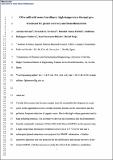Por favor, use este identificador para citar o enlazar a este item:
http://hdl.handle.net/10261/143695COMPARTIR / EXPORTAR:
 SHARE SHARE
 CORE
BASE CORE
BASE
|
|
| Visualizar otros formatos: MARC | Dublin Core | RDF | ORE | MODS | METS | DIDL | DATACITE | |

| Título: | Olive mill solid waste biorefinery: High-temperature thermal pre-treatment for phenol recovery and biomethanization |
Autor: | Serrano Moral, Antonio CSIC ORCID ; Fermoso, Fernando G. CSIC ORCID ; Alonso-Fariñas, Bernabé; Rodríguez-Gutiérrez, Guillermo CSIC ORCID ; Fernández-Bolaños Guzmán, Juan CSIC ORCID ; Borja Padilla, Rafael CSIC ORCID | Palabras clave: | Phenol recovery Methane production rate Improved anaerobic digestion Olive mill solid waste Economic assessment Thermal pre-treatment |
Fecha de publicación: | 1-abr-2017 | Editor: | Elsevier | Citación: | Journal of Cleaner Production 148: 314–323 (2017) | Resumen: | Circular bioeconomy has become a major issue for sustainable development in recent years. In the agricultural sector, circular economy focuses on the valorization and the pollution footprint reduction of organic waste. Due to the high volume generated and its high polluting potential, it is necessary to develop an economical and environmentally-friendly sustainable treatment of Olive Mill Solid Waste (OMSW). In the present study, a high-temperature thermal pre-treatment carried out at 170 °C for 60 min and a subsequent phenol extraction were proposed for OMSW valorization. A further anaerobic digestion step was proposed for the stabilization and energy recovery of pre-treated OMSW, with the necessity to study the effect of the inhibitory metabolites generated during the thermal pre-treatment in order to assess the viability of the process. Thermal pre-treatment induced organic matter solubilization and phenol generation with respect to untreated OMSW, with increases of 26.3% and 60.4%, respectively. Phenol extraction allowed the recovery of 1600 mg of hydroxytyrosol per 1 kg of OMSW. Thermal pre-treatment resulted in an improvement in the liquid fraction of both methane yield and methane production rate compared to untreated OMSW up to 16.9% and 6.9%, respectively. Further extraction of phenols produced a more significant enhancement of both methane yield and methane production rate in the de-phenolized liquid fraction compared to untreated OMSW, reaching improvements of 44.1% and 103%, respectively. The proposed economic assessment showed that the combination of high temperature thermal pre-treatment, phenol recovery and the subsequent biomethanization of the substrates was the most attractive treatment option. The economical suitability of the proposed biorefinery concept is favorable for a phenol extract price higher than 67.0 €/kg, 87% lower than the referenced actual price of 520 €/kg. | Descripción: | 35 Páginas; 6 Tablas; 3 Figuras | Versión del editor: | http://dx.doi.org/10.1016/j.jclepro.2017.01.152 | URI: | http://hdl.handle.net/10261/143695 | DOI: | 10.1016/j.jclepro.2017.01.152 | ISSN: | 0959-6526 | E-ISSN: | 1879-1786 |
| Aparece en las colecciones: | (IG) Artículos |
Ficheros en este ítem:
| Fichero | Descripción | Tamaño | Formato | |
|---|---|---|---|---|
| Postprint_2017_JCleanerProduct_V148_P314.pdf | Artículo principal | 250,99 kB | Adobe PDF |  Visualizar/Abrir |
CORE Recommender
SCOPUSTM
Citations
56
checked on 12-abr-2024
WEB OF SCIENCETM
Citations
52
checked on 27-feb-2024
Page view(s)
325
checked on 18-abr-2024
Download(s)
456
checked on 18-abr-2024
Google ScholarTM
Check
Altmetric
Altmetric
Este item está licenciado bajo una Licencia Creative Commons

